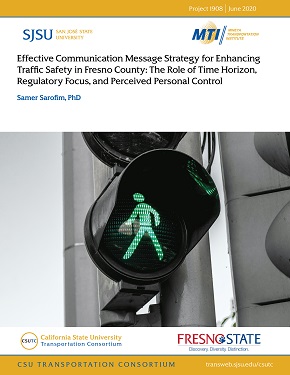- 408-924-7560
- mineta-institute@sjsu.edu
- Donate
Effective Communication Message Strategy for Enhancing Traffic Safety in Fresno County: The Role of Time Horizon, Regulatory Focus, and Perceived Personal Control
This research empirically investigated the differential effect of message framing on message recipients’ attitudes and intended behaviors related to pedestrian, cyclist, and motorist traffic safety practices. The framework empirically investigated time horizon (expansive vs. limited) and regulatory focus (prevention vs. promotion) message framing.
The time horizon in the message can make someone either think of the future (expansive) or the present (limited). For example, an expansive time horizon message communicates that life is long and directs the focus on the future. On the contrary, a limited time horizon message communicates that life is short and directs the focus on the present moment. The regulatory focus of the message can direct the message recipients’ attention to take certain action to either avoid negative consequences (prevention) or attain positive outcomes (promotion).
The research examined the role of the individual difference of perceived personal control on the perceptions of the presented messages and behavioral intentions to adopt safe transportation practices. Various messages were designed to employ a multilayer framing and fit with a 2 (time horizon: expansive vs. limited) x 2 (regulatory focus: promotion vs. prevention) between- subjects design. Findings suggest the messages adopting the expansive and promotion-focused framing combination seem to be more effective and have a higher tendency to induce positive intentions to act safe on the road for both pedestrians and motorists. Also, perceived personal control serves as a positive significant predictor of various safety-related motivations and intended behaviors. This research experimentally studied the differential effects of time horizon and regulatory focus framing on advancing traffic safety throughout effective messaging, an endeavor that shall benefit transportation authorities, city administrators, policymakers, and the general public. The tested message framing can be adopted in various forms, including text message, billboards, road signs, flyers, educational workshops, etc.
SAMER SAROFIM
Dr. Samer Sarofim is an award-winning marketing scholar and educator. He is a Faculty Fellow at Fresno State Transportation Institute and an Assistant Professor of Marketing at Craig School of Business, California State University Fresno. His research was honored by the Best Paper Award in Consumer Behavior Track at the American Marketing Association Summer conference. Sarofim is also the recipient of Pearson Education Michael Solomon Consumer Behavior Best Paper Award and the Society for Marketing Advances Conference, Retailing Track Best Paper Award. Dr. Sarofim’s research appeared in multiple prestigious academic journals, including the Journal of Business Research and Marketing Letters.
Dr. Sarofim holds a PhD in Business Marketing from The University of Kansas. He also holds an MBA from the American University in Cairo, including a semester at George Washington University in Washington, D.C. His bachelor’s degree in Pharmaceutical Sciences was granted by Ain Shams University.
-
Contact Us
San José State University One Washington Square, San Jose, CA 95192 Phone: 408-924-7560 Email: mineta-institute@sjsu.edu






